Stan and Sue Gausman, along with their son, Grant, are now eight months into welcoming their 102-cow herd under one roof on their dairy farm near Baldwin in northwestern Wisconsin.
They broke ground last fall for their four-row freestall barn, which features 107 sand-bedded stalls, two transition pens, headlocks throughout and adjustable curtains. The cows are proving the investment to be well worth it.
“I love everything about the freestall barn,” Grant says. “My favorite thing is seeing all the cows lying down in the stalls. They are very comfortable.”
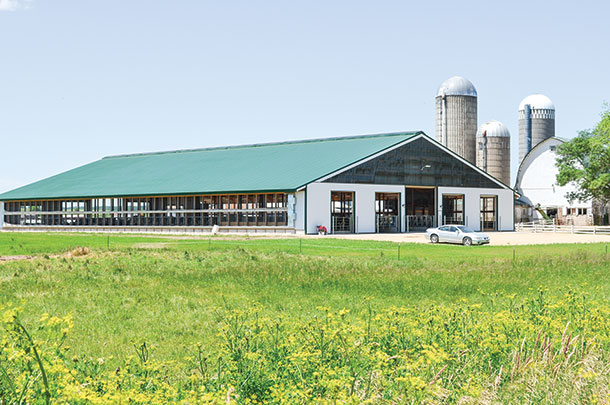
For many years, the Gausmans milked more cows than their 51-stall tiestall barn could hold. The switch cows were kept out on pasture during the summer months and, in the winter months, were housed on bedded packs in two different sheds.
“Whenever it rained, it was a nightmare for our switch cows,” Grant says. “We would battle mastitis and E. coli.”
Stan says building a facility had been on his mind since 2009, but with low milk prices and a house fire in 2010, he held off until Grant, the youngest of five children, returned home after graduating from the University of Wisconsin – River Falls in 2012.
Stan remembers Grant taking over the breeding program upon his return. He had an internship at Accelerated Genetics the summer prior and became very skilled at breeding – so much so, that they experienced an unusual surplus of heifers born nine months later.
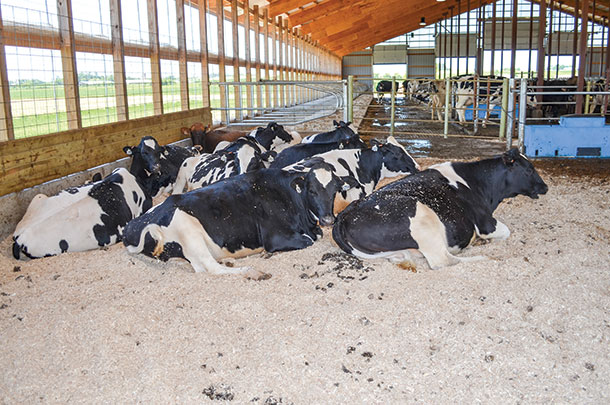
“We had heifer after heifer,” Stan says. “With 40 to 50 heifers born, I knew we needed to re-visit our thoughts on building a new facility.”
After touring many different types of barns throughout the area, Stan and Grant soon realized building a freestall barn was best in line with their future goals. A local company presented them with a design, and they accepted the bid.
The freestall barn stretches east to west and is located 80 feet south of the tiestall barn, which is an easy commute for the cows to get milked twice per day.
“Utilizing the tiestall barn for milking makes sense for now,” Stan says. “A parlor or robots is not out of question for the future but, for now, this will do.”
Carefully thought out, the two milking groups in the freestall barn each contain 51 cows, making the groups easy to transition. The first group contains the first-lactation and smaller cows, and the second group contains the older cows.
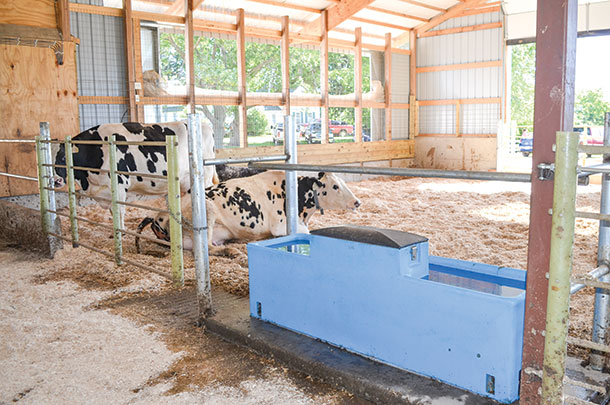
The freestall barn has two different sizes of stalls to accommodate Holsteins, Jerseys and Brown Swiss. Four-foot-by-10-foot stalls are on the outside perimeter of the barn, while 4-foot-by-9-foot stalls are in the center. The neck rails and brisket boards are adjustable, and stalls are deep bedded with sand, which optimizes cow comfort.
“The cows are very comfortable in the stalls,” Grant says. “There is plenty of lunge space. We actually had cows that would never lie down in the tiestall barn, but they’ll lie down with comfort in the freestall stalls.”
Milk production has also significantly improved. The cows currently average 85 pounds of milk per day. Before the heat of summer, the cows peaked at 90 pounds of milk – a 14-pound increase from their tiestall average of 76 pounds.
“I guaranteed my dad that we would see a 5-pound increase per cow per day if we built a barn,” Grant says. “We achieved that within five days of moving all the cows into the new barn.”
Somatic cell count has also been nearly cut in half, from 120,000 to a current average of 71,000. “It continues to fall,” Grant adds.
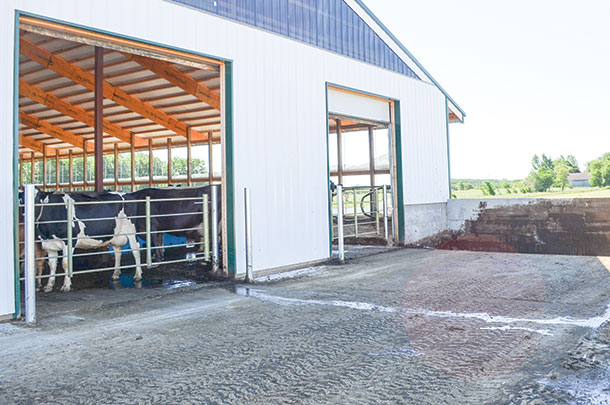
While there are no fans or sprinklers in the barn, the temperature stayed very comfortable all summer due to a natural breeze flowing through the barn.
“One hot summer day, when I was in the tractor getting cooked, I came home and Grant said the cows were up in milk production,” Stan says. “They are doing well in the barn.”
The Gausmans are also happy with the temperature of the barn during the colder months. With guidance from their builder, they chose to install an air curtain system.
“Our builder was very determined that with an insulated roof and [these] curtains, we would have a barn that would perform very well in cold weather,” Stan says.
The builder was correct, as this past winter, when it was -30ºF, the temperature inside the barn never dropped below 21ºF except when the TMR mixer came through the large door, which it then dipped to 19ºF.
“We are so happy with the curtains,” Stan says. “Once inflated, they create a tight seal and light comes through easily.”
The top section of curtains is controlled by two thermostats; one is set to 20ºF, and the other is set to 0ºF. The bottom section is controlled by a switch.
Another unique feature of the barn is that the Gausmans raised the ridge gap on the roof, which prevents precipitation from falling into the center of the freestall barn.
“I told our builder that if we were going to build a barn, I didn’t want anyone to feel the rain inside the barn,” Stan says.
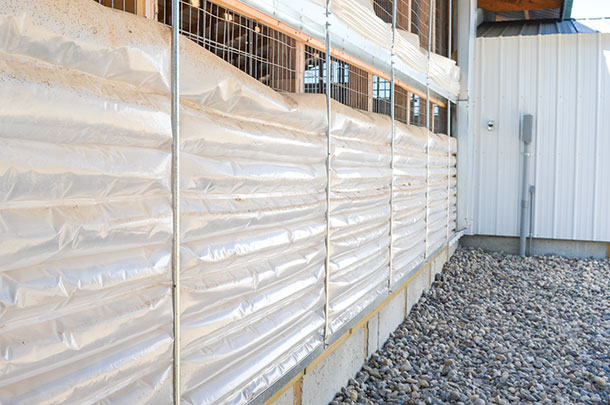
Grant says the two pens at the end of the barn, which were originally an afterthought, are one of his favorite areas.
“The pens provide the extra room we need,” Grant says. “The nice thing is that they are flexible and can change with our needs.”
Currently, the Gausmans have breeding-age heifers in the south pen and pre-fresh cows in the north pen. Each pen measures 36 by 31 feet. Stalls can be added to the pens at any time.
Even with such careful planning, the Gausmans do have a few things about the barn they wish they could change. For Stan, it’s the capacity of his daily manure storage.
“Our daily manure storage at the end of the barn should have been at least 4 feet longer if not more,” Stan says. “It worked perfect at first but, as milk production increased, so did the manure. We now have to haul manure twice per day because our storage can’t handle it.”
Grant adds that the 10-foot alley between the stalls should have been 2 feet wider. “It would allow for more even distribution of manure, and the skid steer would have more room to turn around.”
Grant also wishes they would have installed a walk-in door at the west end so the overhead door could stay closed in the winter.
Even with a few desired changes, the freestall is proving its worth on the farm for both Stan and Grant.
“My favorite thing about the barn is how open it is,” Stan says. “We can easily catch cows in heat, and it has good ventilation without the need of fans.”
“Overall, the barn is allowing us to be more efficient with our time,” Grant adds. “It is a welcomed addition.” ![]()
PHOTO 1: The Gausman dairy farm near Baldwin, Wisconsin, continues to be a family farm. While Stan and Sue Gausman farm full time with their youngest son, Grant Gausman, their four other adult children still serve an active role on the dairy farm and contributed their agricultural expertise to a freestall design. Standing L-R are: Christian Gausman, a manufacturing engineer; Graham Gausman, a dairy nutritionist; Sue and Stan with Grant Gausman; Veronica Schommer, a large-animal veterinarian, and Bill Gausman, a district sales manager at Dairyland Seeds.
PHOTO 2: A four-row freestall barn proudly stands just south of the original tiestall barn as a reminder of future generations to come.
PHOTO 3: The breeding-age heifers rest comfortably in one of the two transition pens located at the east end of the barn.
PHOTO 4: Prefresh cows utilize the other transition pen. Stalls may be added at any time, but Grant finds great use in having the extra room.
PHOTO 5: A one-day manure storage area is found at each side of the barn on the west end.
PHOTO 6: Curtains keep the barn insulated during the cold months and allow for perfect ventilation during the warm months. Daylight also easily shines through, keeping the barn bright. Photos by Jenny Binversie.
Jenny Binversie is a freelance writer from Wisconsin.




